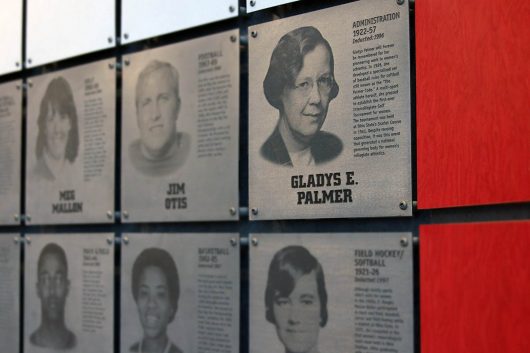
Gladys Palmer was inducted into the Ohio State Athletics Hall of Fame in 1996. Credit: Alexa Mavrogianis | Photo Editor
“Bombshell exploded. Shrapnel flew wildly.”
The first lines of a telegram received by then Chairman of Physical Education for Women at Ohio State Gladys Palmer on April 2, 1941 were not referencing war. Rather, that is how Dorothy Sumption and Violet Boynton – OSU’s representatives at the meeting of the Midwest Association of College Teachers of Physical Education for Women – described the reaction to OSU’s proposed plans to organize a Women’s National Collegiate Athletic Association and sponsor a national golf tournament for women.
Later that month, Palmer attended the National Association of Directors of Physical Education for College Women where the committee proposed new resolutions. Among these resolutions were some that stated disapproval for “national tournaments of any sort for college women” and any organization that might “increase the number of competitive events for women.”
The resolutions effectively struck down OSU’s proposal for a women’s NCAA. However, with a combination of the conviction of OSU faculty, the newly constructed OSU Scarlet course and OSU being the site of the NCAA tournament in 1941, the national golf tournament for women became a reality. The tournament, which had 38 participants, made history as the first national championship for all of women’s collegiate sports.
By the 1940s, OSU had long been at the forefront in advancements for women’s collegiate athletics. In 1923, OSU began its intramural sports program for women. After sending a delegate to the National Athletic Conference of American College Women in 1924, it became clear that OSU’s program was at the top of the pack.
“Run up another flag on the Stadium! Ohio State has achieved another superlative rank! This time it’s in women’s intramural sports,” read the April 30, 1924 issue of The Lantern. “The right to this title was given to Ohio State at the Athletic Conference of American College Women.”
OSU continued pushing boundaries by organizing intercollegiate ‘play days’ with other local universities. When concerns were raised about what to do with higher-skilled women, the push for national level collegiate competition began.
It wasn’t until 1949 that scheduled women’s intercollegiate competitive seasons began, but according to former Associate Director of Athletics Phyllis Bailey, it was the golf tournament that truly set the stage for the biggest advancements.
“It was because of the golf tournament that Ohio State wrote their own rules for women’s intercollegiate athletics,” Bailey said. “We were probably the only ones’ in the country that had that.”
OSU women’s golf coach Therese Hession also acknowledged the golf tournament’s impact.
“I feel like that’s a tradition I don’t take lightly,” Hession said. “Every day I want to work to keep us in that mix and honor what some people started a long time ago.”
Along with Palmer, Bailey is one who is often credited with building OSU women’s athletics into what it is today. When she first came to OSU in 1956, she had originally intended to work with women’s sports while getting her PhD. Upon joining the staff, she was appointed to coach the basketball team. The reasoning? She was the tallest member of the faculty.
“Sometimes people say, ‘Oh, you were the first coach of the women’s basketball team.’ And, I guess I was, but the story behind it isn’t what you would think,” she said. “Coaching was done differently then.”
Following a 1958 car accident that killed Sumption — who at the time was serving as the coordinator of women’s sports — Bailey became her successor. She no longer had time to study, and building the athletics program became her main priority.
By 1964, OSU women’s sports had intercollegiate competition with other schools in Ohio for 15 years but women’s athletics were still viewed as clubs. Bailey, feeling as though it was time for the program to garner more recognition, put together an agenda for an upcoming faculty meeting with both the men’s and women’s departments.
“I said, ‘I’d like us to be honest. We’ve got what the university considers to be a sports club, but we’ve got intercollegiate rules for it and we are calling them intercollegiate teams. Why don’t we just say we have an intercollegiate women’s program?’” Bailey said.
Following that meeting, a plan for a women’s version of the NCAA started to form once again, and Bailey helped oversee the establishment of the Association for Intercollegiate Athletics for Women in 1971. At that time, Bailey’s program at Ohio State had 11 intercollegiate teams, but she was given only $1,100 for expenses, forcing her to put down some money of her own.
However, issues of funding began to be alleviated with the introduction of Title IX two years later.
Between the women’s movement of the late ‘60s and the introduction of Title IX, women’s athletics saw rapid expansion throughout the 1970s. By the end of the decade, the school had added varsity field hockey, gymnastics, softball, synchronized swimming, tennis, track & field and volleyball to the women’s athletics landscape. The school also hired physicians and trainers for the women for the first time.
When Title IX officials traveled the country to check on compliance amongst universities, OSU was so advanced within women’s athletics that the officials accused the athletics staff of lying.
“They said, ‘There’s no way your program is that put together at this point,’ but it was,” Bailey said. “And it started because there was a woman way back who thought that other women who were good deserved a chance to play. I’ll always give the credit to Gladys Palmer for getting that golf tournament together.”
About a decade after the Association for Intercollegiate Athletics for Women was put into place, the NCAA began accepting women’s athletics, forcing the women’s department and men’s department to merge.
Bailey said that many women were angry about the merger, feeling as though what they had worked for had been taken away from them. Bailey’s perspective, on the other hand, was that they should be proud women had gotten athletics “far enough to where (the men) want it now.”
The growth of women’s athletics at OSU did not end with being accepted into the NCAA. Further battles for equal pay among faculty and scholarship awards for female athletes endured. Bailey preached patience on these issues to her staff, likening it to sowing seeds. Upon her retirement in 1994, she said she had felt accomplished despite having “some bruises in the process.”
“All my friends were always upset, saying you do all this stuff and don’t get any credit for it, but I don’t care,” Bailey said. “I was trying to build a program for girls that really liked good sports, I wasn’t trying to build a life of newspaper headlines that this team is No. 1 in the nation.”
Following Bailey’s retirement, more varsity athletics for women were added in the form of rowing (1995), lacrosse (1996), ice hockey (1999) and soccer (1999). Hession – who has been on staff for 25 years, making her the current longest tenured female coach – has seen this additional growth first hand.
“It’s been great to get opportunities to young ladies, and especially in the fashion that Ohio State does it,” Hession said. “Everything is first class, and when they add (teams), they don’t just add it halfway, they add it to give those kids the full opportunity to be prepared and play at the highest level.”
Hession, who cited improvements among the coaching and facilities available to women’s athletics, said she believes the goal for women’s sports is to continue to push forward.
“I think to use your wildest imagination of where (the future) is going to is important,” Hession said. “You don’t want to be satisfied where you are, you want to keep moving ahead.”
Bailey said she believes that equality in sport — and in general — is closer than ever before, and the prospect of future generations having opportunities she did not, offers her satisfaction.
“I retired with the knowledge that the program is going to keep growing and getting better and better, and it is,” Bailey said. “For me that’s a real success, knowing that a student is doing what I always wished I could do. I’m so glad she’s getting that chance.”


